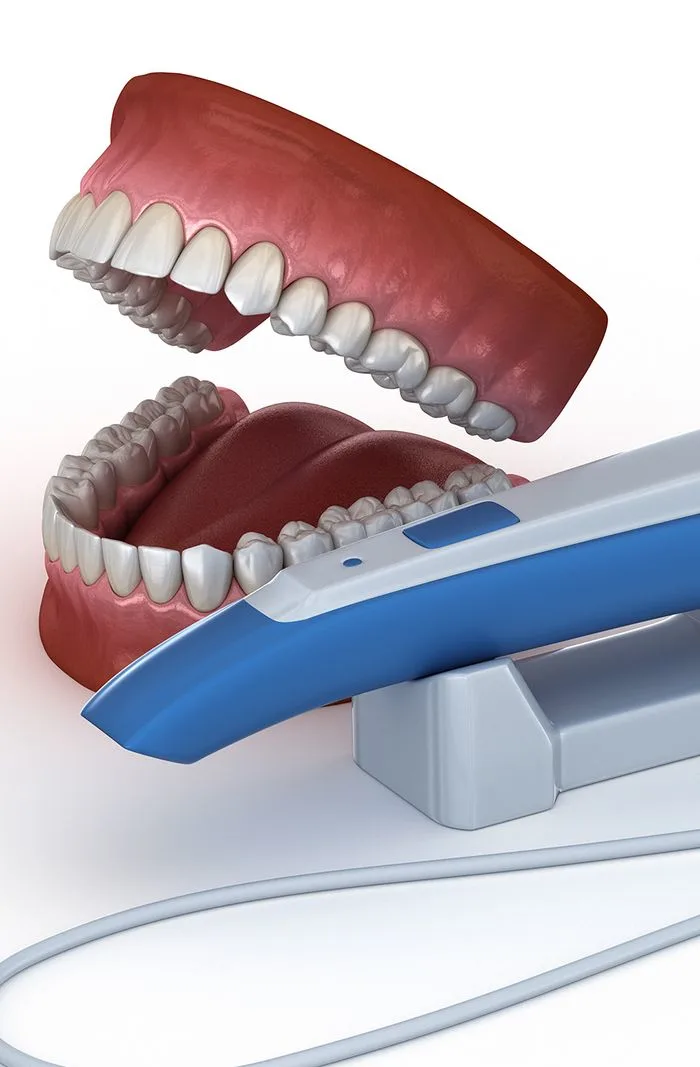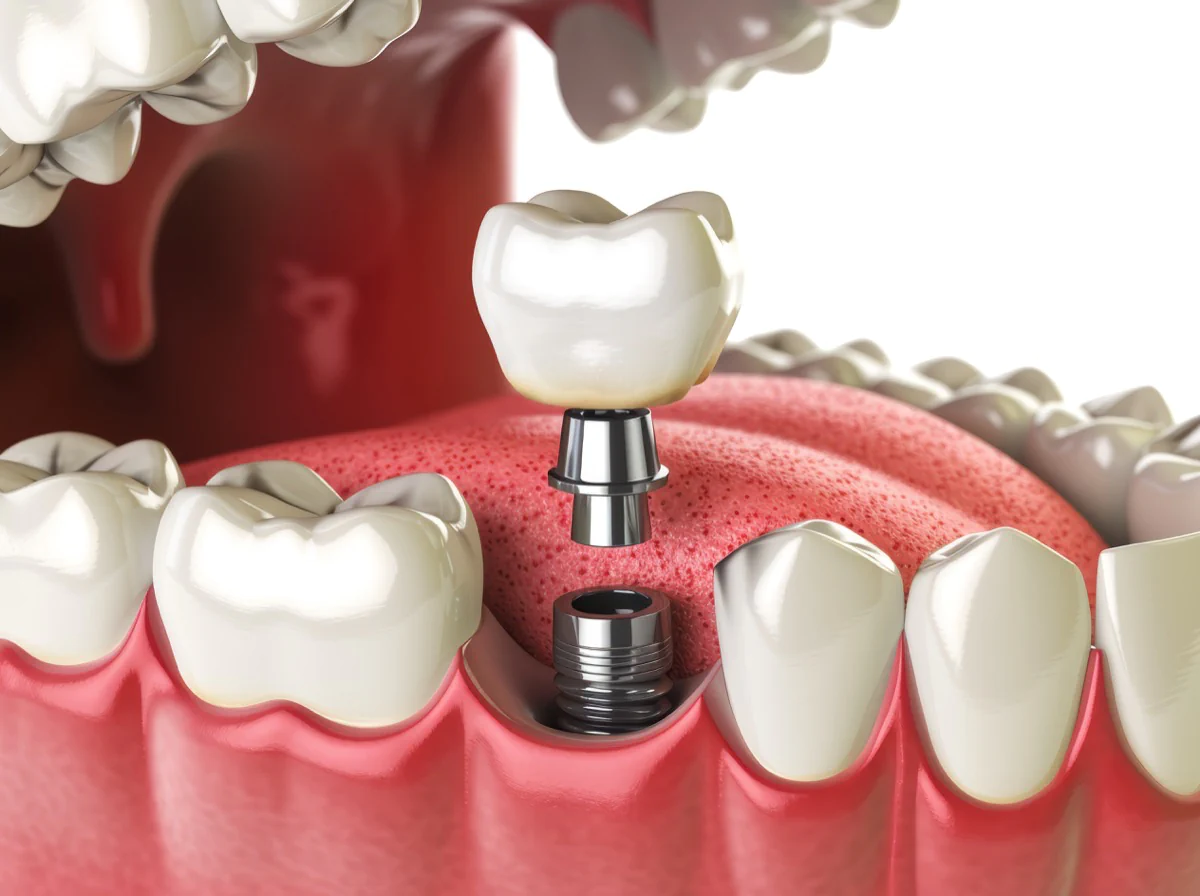Crowns and Bridges
in Leawood, KS

What are dental crowns and bridges?
Dental crowns and bridges allow dentists to protect and restore damaged teeth. Typically, when tooth decay is severe enough that it can’t be treated with a filling, a dental crown will be used to cover, or cap, the tooth. Crowns are also commonly used to seal teeth that have been treated with root canal therapy and occasionally, dental crowns are used for cosmetic purposes or in smile makeovers.
A dental bridge is a type of dental work that replaces a tooth or a few consecutive missing teeth. Two dental crowns are placed on the healthy teeth living on either side of the gap left by your lost tooth. A false tooth, or pontic, is attached to the crowns and literally bridges the gap, replacing your missing tooth.

No Putty Necessary
Say goodbye to goopy impressions! Our 3D intraoral scanner allows us to capture images and create models of your tooth for a digital, mess-free procedure.

Restore Your Arch
Missing more than just a couple of teeth? There’s no need to wait in pain and discomfort any longer. Implant-retained bridges can replace the entire arch of your grin for a sturdy, seamless smile.

You’ve Got Options
Bridges aren’t the only way to restore your missing teeth. Dental implants are one of the most secure dental replacement options available. They can completely mend the functionality of your bite, improve your overall health, and bring back the smile you’ve been hiding.
Flexible Financing Options
- Healthcare Lenders
- Membership Plan
- Insurance-Friendly Office
Your Care, Your Terms
You deserve affordable, accessible care. That’s why we provide a variety of flexible financing options to meet your unique needs. Ready to work out a budgeting plan? Reach out to our team to get the conversation started.
How dental crowns and bridges work together
Preparation of Abutment Teeth
Your dentist will clean and numb your mouth, and then begin to trim away a thin layer of enamel from the two teeth next to your missing tooth. These are known as “abutment teeth” and they will hold your crowns. Your bridge will permanently attach to these crowns.
Impressions or Digital Models
Once your abutment teeth have been prepared, your dentist will take impressions or models of your teeth. These impressions or digital models will be used to build a custom-fit dental bridge.
Temporary Bridge
Depending on your needs, your dentist will place a temporary resin bridge to protect your prepared abutment teeth, or two temporary dental crowns. Either way, your prepared teeth will be covered and protected until your permanent bridge can be placed.
Bridge Check & Adjustment
Once your permanent bridge is ready, usually within a few weeks, you’ll come into the office to have the bridge checked for proper fit. Minor adjustments may be made by your dentist, if necessary, to ensure that your bridge looks and feels natural. If the bridge requires larger adjustments, it will be sent back to the lab for further refinement.
Permanent Placement
Once you and your dentist have determined that the fit of your bridge feels right, they will use powerful dental cement to attach it permanently to your abutment teeth, restoring your smile and your bite.
Frequently Asked Questions
Check out these frequently asked questions, or call us to speak with our team.
How are crowns and bridges related?
Both dental crowns and bridges protect and restore damaged teeth to their normal shape, size, and function. A crown restores one decaying tooth by covering it with a cap, while a dental bridge restores multiple teeth through a fixed appendage that mimics the look and feel of your other teeth.
How much do dental crowns and bridges cost?
The cost of dental crowns and bridges is different for each patient. Factors that may affect the cost of your crown or bridge include your overall oral health, the type of crown or bridge you choose, pre-treatment surgeries (like tooth extraction) and more. The best way to find out how much you’ll pay for a dental bridge is to schedule a consultation with our office.
If your insurance has out-of-network coverage, they may reimburse you for a portion of the cost of a crown or bridge at our office. Contact your insurance provider to learn more about your coverage.
How to do crowns and bridges work?
While every type of bridge is different, dental bridges all share similar characteristics and work in the same way. A bridge is used to attach one or more false teeth to your existing teeth – locking them into place by using dental crowns (fixed and cantilever bridges) or metal “wings” that attach to the rear of your teeth (Maryland bridges).
Because they won’t move or shift, they’re a great alternative to partial dentures. And since they do not require invasive surgery, some patients prefer dental bridges as an alternative to dental implants.
What issues can a dental crown and bridge treat?
Most commonly, dental crowns and bridges are used to protect and restore teeth that have been damaged by a serious cavity, or that have been cracked or broken by dental trauma, like an accident or injury. Because crowns and bridges cover up and protect your entire tooth structure, they are ideal for preventing further complications and restoring the shape, appearance, and function of damaged teeth.
Dental crowns and bridges are also used to cover up and protect teeth after root canal treatment. In more rare cases, they may also be used for cosmetic dentistry if other treatments like veneers and dental bonding are not appropriate.
How do I know if I need a dental crown or bridge?
If you have one or more damaged or severely decayed teeth, you may need a dental crown or bridge. You should see a dentist if you are experiencing tooth pain and discomfort, or if your teeth are visibly damaged or discolored. Depending on the cause of your dental issues, we may recommend a dental crown, dental bridge, or another restorative treatment.
How long do dental crowns and bridges last?
A well-made and properly placed dental crown and bridge will typically last up to 15 years. It’s critical to maintain good oral health habits to enhance your crown’s longevity. These practices include brushing twice per day, flossing once per day, and seeing us every 6 months for a professional cleaning and exam. Same-day crowns can be a little less durable, but they can still last several years with proper care.
How do I care for my dental crown and bridge?
You can treat your dental crown and bridge just like a natural tooth. Make sure you brush twice a day for at least two minutes, ensuring you scrub the full surface of every tooth. You should floss at least once per day, preferably at night. This should only take a few minutes, but be sure to floss against the tooth and below the gum line. You should also see our team every six months for a check-up to make sure that your dental work and teeth are healthy.
Can dental crowns and bridges be repaired or replaced?
Yes. Dental bridges, just like all dental prostheses, can become damaged over time, or simply worn down from daily use when chewing, biting, smiling, and speaking. Typically, bridges last between 10-20 years, but the expected lifespan of your bridge may be different depending on the type of bridge, how well you care for your teeth, and a few other factors.
What are dental crowns and bridges made of?
This varies, depending on the type of dental crown or bridge you choose. However, most dental crowns and bridges are made from a combination of a metal framework, which supports the teeth and ensures they’re in the proper place, and one or more porcelain crowns and false teeth. Acrylic teeth are sometimes used for dental bridges and crowns, but usually, they are only used for temporary bridges and crowns, since acrylic is much less durable than porcelain and ceramic materials.
